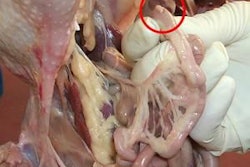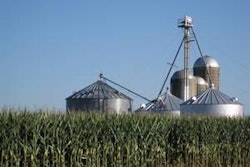The nutritional and economic benefits associated with reducing particle size in swine diets have been recognized for many years. As a general rule for every 100micron reduction in particle size, a 1.2% improvement in feed efficiency can be achieved. The net benefits of reducing the particle size of the diet depends on other factors such as ingredient and grinding costs, production rate and whether diets are fed as mash or pellets.
The uniformity of particle size (Sgw) is commonly regarded as an important nutritional variable. There is little evidence to directly support this claim, unless in the context that particle size uniformity contributes to bridging in the feeder. Some studies have demonstrated an inverse relationship between a decrease in uniformity of particle size and the occurrence of feed bridging which may result in transitory feed deprivation. The relationship between particle size and uniformity depends largely on whether the feed is pelleted. Pelleting feed minimizes bridging and hence the importance of uniformity in particle size. Nonetheless, measuring particle size and uniformity remain fundamental aspects of most quality assurance programs within the feed and swine industries.
Particle size is determined and expressed by screening a 100 gram sample of feed or ground grain. The sample is placed onto the top of a series of thirteen sieves (screens). The sieves are stacked, with the largest mesh size at the top and placed into a shaker. The feed or grain particles pass through the sieves as they are being agitated until reaching a sieve with a mesh too small for the particles to pass through. The weight of material remaining on each of the sieves can then be measured and used to calculate the geometric mean particle size (dgw) and the geometric standard deviation (Sgw), which represent the median particle size and particle uniformity respectively.
A more detailed description of the test equipment and procedure to determine dgw and Sgw is found in the ASABE Standard S319.4.
Screening questions increase
During the past few years Kansas State University has received an increase in questions regarding discrepancies among results of particle size assays obtained from different laboratories. Questions have included: “I’ve sent representative samples to three different labs, and received three different results, why?” The basis for the concerns expressed were that feed mills are being penalized for not delivering diets or producing ground grains of a specified minimum dgw and maximum Sgw. In some cases, the determining factor as to whether a penalty was imposed was based on discrepancies between laboratories conducting the particle size analyses.
These inquiries prompted examination of the accepted standard for determining and expressing fineness of feed materials by sieving (ASABE S319.4). It was ascertained that the ASABE Standard incorporated considerable latitude relative to the accepted test equipment and methods.
Research conducted at KSU specifically examined the following sections of the Standard:
1.) Section 4.2 - A sieve shaker, such as a Tyler Ro-Tap, Retsch, or equivalent unit, is required;
2.) Section 4.4 - Sieve agitators such as plastic or leather rings, or small rubber balls may be required to break up agglomerates on finer sieves, usually those smaller than 300mm in opening (ISO 3310-1) or US sieve No. 50;
3.) Section 4.5 - A dispersion agent can be used to facilitate sieving of high-fat or other material prone to agglomeration; and
4.) Section 5.2 - Place the charge on one sieve or the top sieve of the nest of test sieves and shake until the mass of material on any on sieve reaches end point. End point is decided by determining the mass on each sieve at 1-minute intervals after an initial sieving time of 10 minutes. If the mass on the smallest sieve containing any material changes by 0.1% or less of the charge mass during a 1-minute period, the sieving is considered complete. For industrial applications, the end-point determination process can be omitted, and the end-point is set to be the sieving time of 15 minutes.
Comparison between sieve shakers
The Tyler Ro-Tap sieve shaker is the most commonly used apparatus in the feed industry. The Standard states that a Retsch sieve shaker can be substituted. Though both units facilitate the passage of feed particles through the sieve stack, one could argue that the motion of feed particles within the sieve stack is different when comparing Retsch and Tyler Ro-Tap sieve shakers.
We have observed consistently that a lower dgw (≈ 90 µ) and higher Sgw (≈ 0.42) will be obtained using a Retsch sieve shaker compared to the alternative. Controlled trials have demonstrated that if a split sample were to be sent to two different quality control labs, the first equipped with a Tyler Ro-Tap sieve shaker and the other with a Retch sieve shaker, the results would be different. Data obtained from the first lab would correspond to dgw = 600 µ and sgw = 2.0, compared to the second laboratory with a Retch shaker which would report values of dgw = 510 µ and sgw = 2.42.
Sieve agitators, sieving time effects
Most QC laboratories use sieve agitators operated for a total of 10 minutes. Generally the mass on each sieve is not measured at 1 minute intervals after 10 minutes of sieving to determine the end point. The KSU Laboratory was interested in quantifying the extent to which sieve agitators and sieving time affect the results of an assay for particle size. In order to evaluate these variables, a sample of ground corn was split into multiple samples using a Boerner Divider. Each of the sub-samples was then evaluated for particle size and uniformity using a sieve stack, with and without sieve agitators, applying a sieving time of either 10 or 15 minutes, as suggested in the Standard. All treatments were evaluated using a Tyler Ro-Tap sieve shaker and were replicated three times.
On average, the sieve agitators reduced the dgw by 80 µ and increased the Sgw from 1.87 to 2.15. Sieving time also affected results. Sieving for 15 minutes rather than for 10 minutes resulted in a lower dgw (approximately 40 µ) and a slightly higher Sgw (2.15 vs. 2.31).
Dispersion agents are common
Using a dispersion agent such as Supernat 22-S or Cab-O-Sil has become common in the feed industry. The effect of a dispersion agent on particles size determination was evaluated using over 600 ground corn samples ranging from 400 to 1000 microns. It was found that a dispersion agent reduces the dgw by approximately 80 µ, and produces a larger deviation in particle size. This was consistent across the range of particle sizes evaluated. Dispersion agents have a similar result, reducing dgw by 75 µ.
Significant deviations reported
It is evident that different procedures and equipment can induce significant deviations in results reported by laboratories apparently following the Standard. Feed mills obliged to produce ground grain with a specific dgw and Sgw may face challenges if their in-house QC laboratory is following different procedures compared to an outside laboratory.
Questions are raised as to the nutritional importance of Sgw considering the fact that sieving equipment, sieving time, the use of dispersion agents and cleaners can result in differences in measurement.
In addition, studies at KSU failed to find any significant difference in growth rate, nutrient digestibility or stomach morphology in finishing pigs due to the inherent range of particle size (Sgw) in grain ground to approximately the same particle size and uniformity.

















